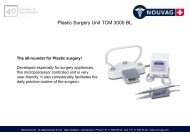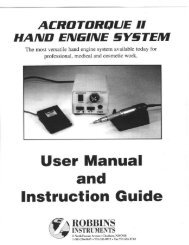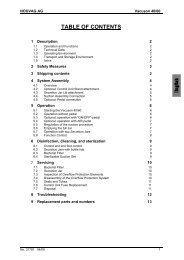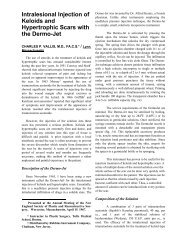Intralesional Injection Of Keloids And Hypertrophic Scars - Robbins ...
Intralesional Injection Of Keloids And Hypertrophic Scars - Robbins ...
Intralesional Injection Of Keloids And Hypertrophic Scars - Robbins ...
You also want an ePaper? Increase the reach of your titles
YUMPU automatically turns print PDFs into web optimized ePapers that Google loves.
scars is well documented. I have added the Wydase to<br />
the steroid solution because it appears to cause greater<br />
diffusion of the solution. I also believe that it lessens<br />
the stinging pain which often results after injection of<br />
the steroid. Cornbleet 5 stated that infiltration of the scar<br />
with Hyaluronidase produces softening even of old,<br />
hard keloids and some diminishing in size.<br />
Method of Treatment<br />
The technique is simple and is performed as an<br />
office procedure. Several patients are usually done<br />
simultaneously to prevent wastage of the solution. Only<br />
the plastic cuff on the end of the instrument needs<br />
sterilization between patients. No type of anesthesia is<br />
required. The scar to be injected is sponged off with a<br />
mild antiseptic solution. With each injection by the<br />
Dermo-Jet, a pale white wheal measuring<br />
approximately 1 to 1.5 cm. in diameter is attained. The<br />
injections are spaced so that the wheals from each<br />
injection more or less touch each other and fuse. The<br />
entire scar is injected at one sitting. In the smaller scars<br />
only 1 or 2 injections may be needed. As many as 25 to<br />
30 injections have been done for some of the larger<br />
scars. The instrument is placed vertically over the scar<br />
so that the removable and easily sterilized plastic cuff<br />
on the end touches the scar (fig. 2). Rarely, when there<br />
is a small area to inject, the plastic cuff may obscure the<br />
lesion. Then it is wise to remove it and keep the nozzle<br />
of the instrument approximately ½ cm. above the scar.<br />
After the first treatment is completed, the<br />
patient is advised to return again in 2 weeks, at which<br />
time a second injection is done if necessary. After the<br />
second injection series, the patient is advised to come<br />
back in a month. Many patients do not require more<br />
than 2 series of injections. However, the larger keloids<br />
may require several doses. One had a total of 10 series<br />
of injections spaced about 1 month apart.<br />
For the initial injection it is best to acquaint the<br />
patients with the machine and allow them to hear the<br />
“snap” of the machine before giving the injection.<br />
Many of the younger patients are frightened by the appearance<br />
of the machine and the snapping sound. This<br />
sometimes makes them hypersensitive to the small<br />
amount of pain caused by the injection. By and large,<br />
these patients are much more cooperative for<br />
subsequent injections.<br />
Table I<br />
Location No. of Patients<br />
Left shoulder 6<br />
Arms 6<br />
Anterior chest wall 4<br />
Face 3<br />
Abdomen 3<br />
Thigh 1<br />
Foot 1<br />
Hand 1<br />
Mastoid 1<br />
Neck 1<br />
Back 1<br />
Total 28<br />
Clinical Material<br />
Since November 1965, 28 Caucasian patients<br />
with keloid or hypertrophic scars have received a<br />
combined total of 64 injection series of this mixture of<br />
triamcinolone acetonide and Wydase.<br />
The ages of 22 patients ranged between 6 and<br />
29 years, and the other 6 patients were between 33 and<br />
70 years of age. The average age was 22 years. Seven<br />
were men and 21 were women.<br />
<strong>Of</strong> the 22 patients in the younger age group, 14<br />
had scars which were considered to be true keloids. All<br />
the scars treated in the older age group were<br />
hypertrophic scars. The locations of the scars are shown<br />
in table 1.<br />
The causes of the scars varied. <strong>Of</strong> the 14<br />
keloids, 6 were the result of vaccinations, 3 resulted<br />
after surgical excision of benign lesions, I from a burn,<br />
2 from infection due to acne and 2 from injury. <strong>Of</strong> the<br />
14 hypertrophic scars, 8 resulted from operative incisions,<br />
3 from injuries, 2 from burns and 1 from<br />
dermabrasion on the face. At the time of the initial<br />
treatment of these patients, the lesions had been present<br />
from 2 months to 10 years with an average of 3 years.<br />
A total of 64 series of injections ranging from<br />
1 to 10 were given to the 28 patients. Nine are still<br />
under treatment. A total of 49 series were given to the<br />
completed 19 cases, making an average of 2.6. <strong>Of</strong> the<br />
28 patients treated, 14 had no symptoms referable to the<br />
scars, and they were primarily interested in improving<br />
the appearance of the scars. In the remaining 14, the<br />
most common symptoms were chronic itching and pain.<br />
<strong>Of</strong> these 14, 10 were interested in relief of symptoms<br />
and improvement of the appearance of the scars. The<br />
remaining 4 were interested only in relief of symptoms






